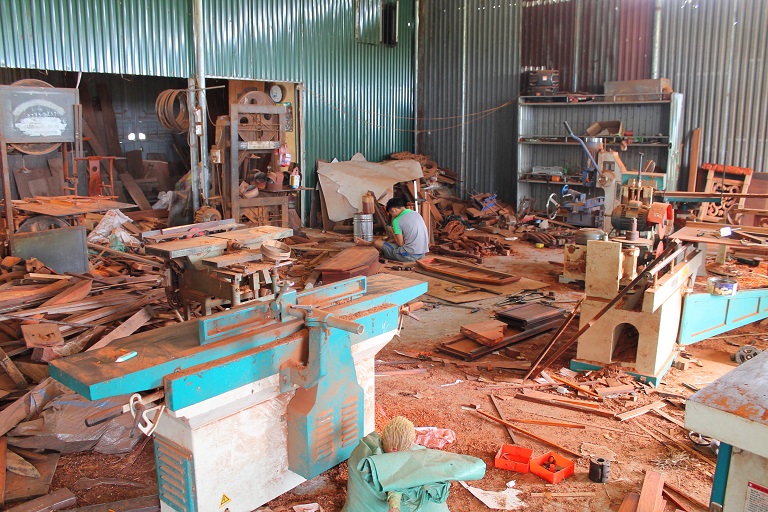- Vietnam exported nearly $1 billion worth of timber products to China in 2019, but the trade faces a steep decline as a result of the coronavirus outbreak.
- There were 93 Chinese-owned companies operating in Vietnam’s timber product export sector in 2019.
- Only 16 confirmed COVID-19 infections have been reported in Vietnam, but the economic fallout of the outbreak will be immense.
HO CHI MINH CITY — As an outbreak of the novel coronavirus disease (COVID-19) has raged in its northern neighbor China over the past several weeks, Vietnam has been impacted in some perhaps unexpected ways.
While the country’s human toll has been small — just 16 confirmed infected individuals, 15 of whom have since recovered, out of a population of 96 million people — the economic effects have been wide-ranging, and are still developing.
Public schools nationwide have been closed since mid-January, first for the Lunar New Year holiday, and then out of an abundance of caution regarding the outbreak. They will remain closed for the remainder of this month. The tourism industry may lose more than $7 billion, Reuters reported, as China is Vietnam’s largest international tourist market, and arrivals have dropped by up to 100% amid a suspension of all flights between the two countries. Other visitors are avoiding the country, given its proximity to China.

Vietnam’s timber sector, though not as visible as tourism, is also suffering. According to Phuc Xuan To, program analyst at Forest Trends, in 2019 Vietnam exported $972.2 million worth of timber products to China. Meanwhile, it imported $395.5 million worth of timber products from China. These figures were compiled from Vietnam Customs data that isn’t publicly available.
Cross-border trade of all products has been severely hampered by the COVID-19 outbreak, with only limited numbers of cargo trucks and trains allowed to travel between the two countries. This has resulted in a variety of unusual developments.
For example, many of Vietnam’s dragonfruit and watermelon farms export their produce to China, but trucks carrying these fruit have been stuck at the border for weeks. On the streets of Ho Chi Minh City, watermelons are currently on sale at rock-bottom prices as farmers desperately try to offload their goods before they rot.

One bakery in the city has gotten particularly creative by purchasing tons of dragonfruit and using it to bake bread.

Timber products, however, aren’t intended for the average consumer, and businesses in the sector will be hit hard, Phuc said.
“The biggest impact for this sector is the disruption of trade between Vietnam and China,” he said. “Woodchips are the most important product exported from Vietnam to China, and now that pulp and paper companies in China are not operating, or are not operating at full scale, imports have slowed down.”
Figures on exactly how much trade has dropped aren’t available yet.
Products going in the other direction are slowing down as well.
“Plywood is the most important timber product exported to Vietnam from China,” Phuc said. “The outbreak has caused the disruption of this trade, and if the outbreak is not controlled within a couple of months, companies in Vietnam importing plywood from China will run out stock.”
China also supplies accessories like locks and hinges to Vietnam’s huge furniture industry, as well as materials like paint and metal products. The production and shipment of these goods are now up in the air as well.
Vietnam is an important producer of traditional wood furniture for the Chinese market. Many of these products are produced in a few towns near Hanoi where regulations on timber sourcing are poorly enforced. Southern Vietnam is an important manufacturing hub for furniture intended for the U.S. market using U.S. timber, but metal parts and other materials are imported from China for that production as well.

Beyond material goods, companies operating within Vietnam’s timber sector also face personnel shortages. According to Forest Trends figures, as of last year there were 184 Chinese-owned companies registered in the country’s wood sector, 93 of which were working in the timber product export sector.
Chinese employees are now unable to return to Vietnam if they traveled home for the Lunar New Year, while those who stayed in Vietnam have been quarantined for 14 days under government orders.
As a result of these difficulties, Vietnam’s overall exports in the first quarter of this year may fall by as much as 20%, according to the February Tropical Timber Market Report from the International Tropical Timber Organization (ITTO). The agricultural, forestry and fisheries sectors alone may lose up to $300 million in exports, a figure that could more than double if the outbreak remains severe into the second quarter.
The report also said that several high-profile industry events, including the VIFA Expo, VIFA GU and Hanoi Wood 2020, have been postponed due to COVID-19 concerns, but that appears to be untrue.
According to an official announcement on the VIFA Expo International Furniture & Home Accessories Fair’s website, the event will be held as scheduled from March 11-14 in Ho Chi Minh City. Phuc said Vietnam’s prime minister is expected to host a national conference on the timber sector during the event, though this could change depending on further outbreak developments.
VIFA GU, another furniture and home accessories fair, is still scheduled for May 14-17 in Ho Chi Minh City, while Hanoi Wood 2020 is scheduled for July 30-Aug. 1 in Vietnam’s capital. It is unclear whether those were the original dates. None of the organizers of the three events replied to requests for comment.













